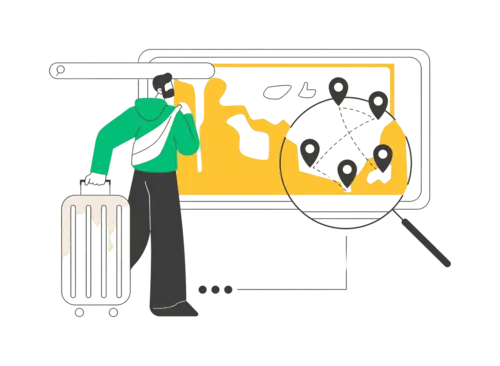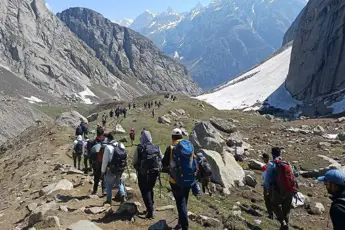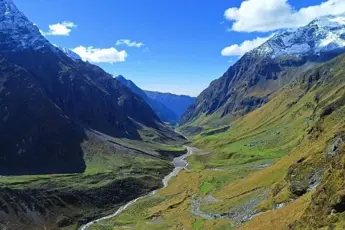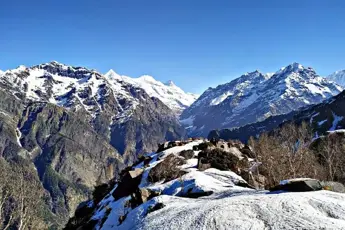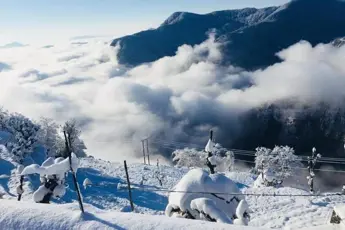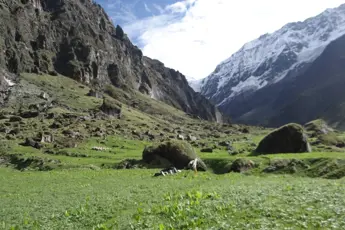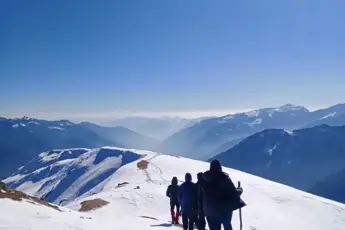Chandigarh
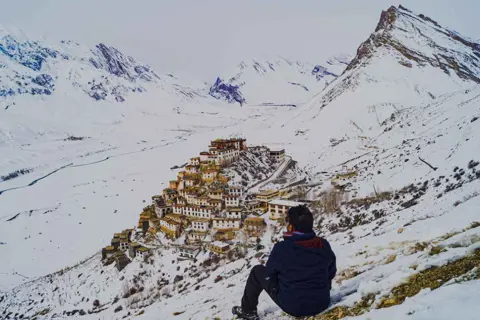
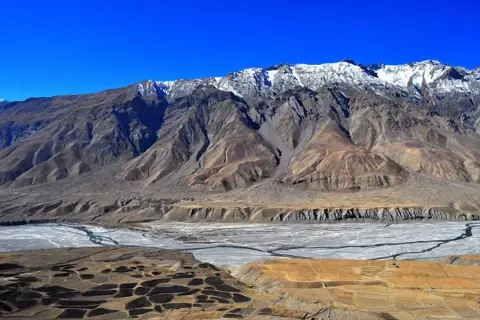
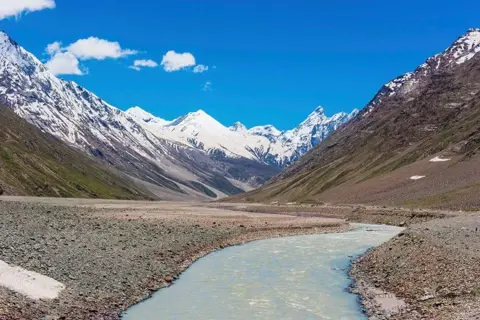
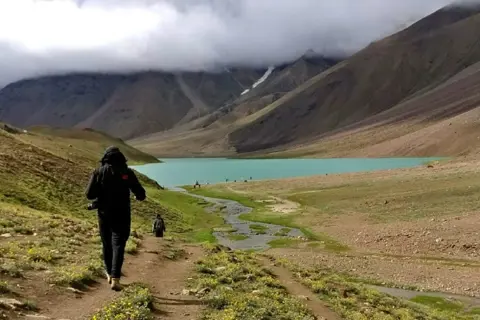
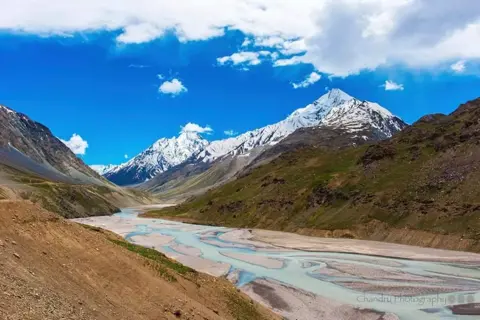

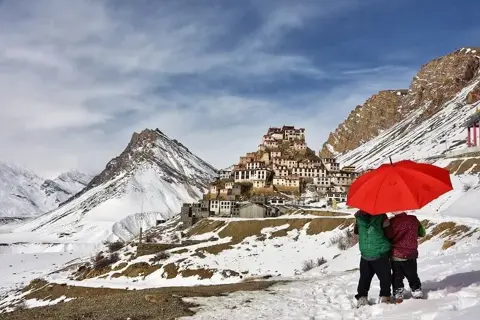
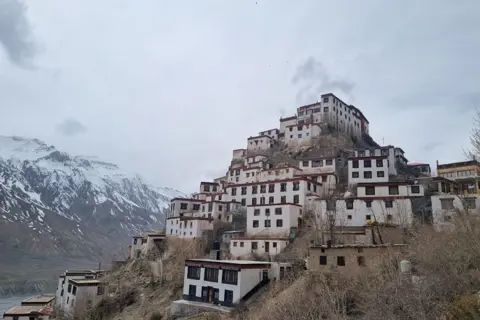
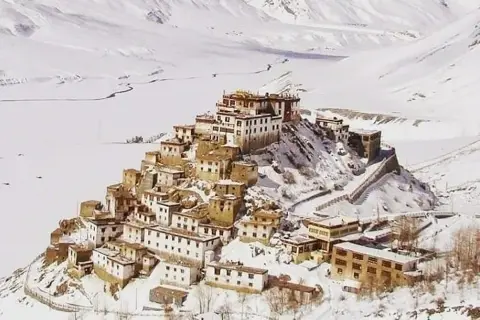



Images


Images
Spiti Valley Trek
Starting from INR 31427
Per Person
( Inclusive of all taxes )
Meal
Permit
Trekking
Guide
Tea Snacks
Transport
Tent Stay
Meal
Permit
Trekking
Guide
Tea Snacks
Transport
Tent Stay
Spiti Valley Trek: Highlights
Embark on a thrilling trek through the high-altitude desert of Spiti Valley with rugged terrains and stunning views.Experience breathtaking panoramic views of snow-capped peaks, rocky cliffs, and valleys while trekking in Spiti.Visit historic monasteries like Tabo and Key Monastery, offering insight into Tibetan Buddhist culture and heritage.Explore remote villages like Kaza and Langza, where you can immerse in local traditions and Tibetan way of life.Conquer high-altitude passes such as Pin Parvati, enjoying mesmerizing vistas of Spiti’s barren, majestic landscapes.Enjoy the serene silence and tranquility of Spiti Valley, far from the hustle and bustle of city life and noise.Challenge yourself by trekking at altitudes of over 4,000 meters, testing your endurance with stunning surroundings.Discover the untouched, pristine beauty of Himachal Pradesh, a region known for its remote charm and natural wonder.
Spiti Valley Trek: Overview
Activity location: Lahaul & Spiti, Himachal PradeshTrip Duration: 8 Days | 7 NightsBest Time to Visit: May to OctoberTrekking Distance: 25-30 Km TrekMax. Altitude: 15,200 ftSpiti Valley Trek Difficulty: Moderate to HardMeals: Vegetarian mealsAccommodation: Camping Tent (Triple/Quad Sharing)About Spiti Valley Trek, Uttarakhand:The Spiti Valley Trek is an unforgettable adventure through one of India's most remote and pristine landscapes. Located in the northern region of Himachal Pradesh, the trek takes you through rugged terrains, high-altitude deserts, and ancient monasteries. The trek is perfect for avid trekkers looking for a challenge, offering a blend of natural beauty, spiritual experiences, and cultural immersion. As you trek through the Spiti Valley, you’ll encounter picturesque villages, striking landscapes, and the chance to explore unique Tibetan culture. The trek spans across high-altitude passes, including the famous Pin Parvati and Spiti River, offering breathtaking views of snow-capped peaks and valleys.The Spiti Valley Trek not only tests your endurance but also rewards you with spectacular views of barren mountains, rocky terrains, and an untouched environment. A journey here means trekking at altitudes of over 4,000 meters, where the weather can be unpredictable. But the hardships are outweighed by the striking beauty of the landscape and the serene silence of the valley. Spiti is also home to some of the most serene Buddhist monasteries, such as the Tabo and Key Monasteries, adding a cultural and spiritual layer to the adventure. The Spiti Valley Trek offers trekkers the opportunity to disconnect from the hustle and bustle of city life and embrace the peacefulness of one of the most remote regions in India. Explore the remote and thrilling Bagini Glacier Trek, a high-altitude Himalayan adventure offering dramatic landscapes, alpine meadows, and close-up views of Changabang and other mighty peaks.Trending Packages: Tungnath Chopta Trek | Kedartal Trek |Swargarohini Trek |Phulara Ridge Trek |Fachu Kandi Pass Trek
Inclusion and Exclusion
This Package Includes:Transportation from ChandigarhTrekkingExperienced & Certified trek leader and local support staffFirst AidAll MealsAccommodationAll Permits And Passes Wherever RequiredExcludes:Trekking Gear Personal equipmentAny additional activities or services not included in the itineraryMeal During Road JourneyPotters Or Mule To Carry Personal LuggageAnything not mentioned in the includes
Tour Plan
Chandigarh to Shimla – Journey Begins
Chandigarh and Shimla is approximately 115 kilometersStart early from Chandigarh to make the most of your day (approx. 115 km, 4-5 hours journey).Choose to hire a taxi or take a bus from the Inter-State Bus Terminus (ISBT) in Chandigarh to Shimla.Enjoy the scenic drive through picturesque landscapes, hills, forests, and small towns on your way to Shimla.Upon arrival in Shimla, check into your accommodation and freshen up to relax after the journey.Explore Mall Road, Shimla’s main street, lined with shops, cafes, and restaurants, perfect for shopping and local delicacies.Visit The Ridge, an open space on Mall Road offering panoramic views of Shimla’s hills and valleys.Check out Christ Church, the second oldest church in North India, and the Viceregal Lodge, a British-era summer residence.Witness the sunset from Scandal Point, one of Shimla’s most famous viewpoints, offering stunning views.Enjoy dinner at a local restaurant, indulging in authentic Himachali cuisine.Retire for the night at your accommodation, ready for the next leg of your journey.
Shimla to Kalpa – Scenic Himalayan Drive
You will be traveling from Shimla to Kalpa, which is approximately 223 kilometers away.Start your day with a hearty breakfast at your accommodation in Shimla and check out.Depart from Shimla and begin your drive towards Kalpa (approx. 223 km, 7-8 hours journey).The route will take you through scenic landscapes, winding roads, and charming towns.Stop at Kufri (16 km from Shimla) for beautiful views and adventure activities like horse riding and skiing.Continue your journey towards Rampur, a historic town by the Sutlej River, and visit Padam Palace and the local market.Travel through the scenic Kinnaur district, enjoy views of the Kinnaur Kailash Range and the Sutlej River.Upon arrival in Kalpa, check into your accommodation and take time to relax and freshen up.Explore Kalpa, a charming village known for its apple orchards and stunning views of the Kinnaur Kailash Range.Visit the Kalpa Monastery (Hu-Bu-Ian-Car Gompa) and learn about the region’s rich Tibetan Buddhist culture.Enjoy a delicious local dinner at a restaurant, savoring the flavors of Himachali cuisine.Retire for the night at your accommodation in Kalpa, resting for the next leg of your Spiti Valley trek.
Kalpa to Tabo via Nako & Gue Monastery
Kalpa to Tabo via Nako village, Gue/Giu Monastery, and spending the night at Tabo.Start your day with a delicious breakfast at your accommodation in Kalpa and check out.Begin your drive from Kalpa towards Nako village, passing through scenic landscapes, winding mountain roads, and villages.Arrive in Nako village and explore its serene beauty by the banks of Nako Lake. Visit the ancient Nako Monastery.Take some time to relax and enjoy the tranquil surroundings of Nako Lake and the majestic mountains.Continue your journey towards Gue/Giu Monastery, where you can visit the 500-year-old mummy of a Buddhist monk.After visiting Gue/Giu Monastery, resume your drive towards Tabo, enjoying views of the rugged mountains and Spiti River.Upon arrival in Tabo, check into your accommodation, relax, and freshen up.Explore the Tabo Monastery, a UNESCO World Heritage Site, known for its intricate murals and ancient Buddhist sculptures.Take a walk around Tabo village, interact with the locals, and immerse yourself in the peaceful surroundings.Enjoy a delicious dinner at a local restaurant, savoring the flavors of Spiti’s unique cuisine.Retire for the night at your accommodation in Tabo, preparing for further exploration of Spiti Valley.
Tabo to Kaza via Dhankar & Pin Valley
Kaza via Dhankar Monastery and exploring Pin Valley and Mud Village.Start your day with a delicious breakfast at your accommodation in Tabo and check out.Begin your drive from Tabo towards Dhankar Monastery, located at an altitude of 3,894 meters with stunning panoramic views.Visit Dhankar Monastery, perched on a cliff above the confluence of the Spiti and Pin Rivers, and explore the ancient Buddhist scriptures, statues, and thangkas.Enjoy the breathtaking views from the monastery’s vantage point, offering a picturesque view of the valley below.Continue your journey from Dhankar towards Pin Valley, famous for its high mountain passes, rich biodiversity, and picturesque landscapes.Explore Pin Valley National Park, home to snow leopards, ibex, and Himalayan birds. Enjoy the serene beauty of the valley and take short hikes.Head towards Mud Village, the last motorable village in Pin Valley. Stroll through the village, interact with the locals, and experience traditional village life.After exploring Pin Valley and Mud Village, continue your drive towards Kaza, the main town in Spiti Valley, located at an altitude of 3,650 meters.Check into your accommodation in Kaza, relax, and freshen up after your journey.In the evening, explore the local market in Kaza, shop for souvenirs, and try local cuisine at one of the restaurants.Retire for the night at your accommodation in Kaza, resting for further exploration of the Spiti Valley.
Kaza & High-Altitude Villages Exploration
Kaza Monastery, Kibber, Chicham, Lanza Village, Hikkim, Comic Village, and Key Monastery.Start your day with a delicious breakfast at your accommodation in Kaza.Visit Kaza Monastery (Sakya Tangyud Monastery), perched on a hilltop, offering panoramic views of Kaza and surrounding mountains.Proceed to Kibber, one of the highest inhabited villages in the world (4,205 meters), and explore the village and Kibber Wildlife Sanctuary.Continue to Chicham Village, famous for its high suspension bridge that connects two villages separated by a deep gorge; enjoy breathtaking views.Visit Lanza Village, a peaceful and quaint village with traditional architecture. Stroll through the village and experience its serenity.Head towards Hikkim, home to the world’s highest post office at 4,400 meters. Send a postcard from this unique location.Proceed to Comic Village, one of Asia's highest villages accessible by motorable roads. Explore the village and visit the ancient Comic Monastery.Explore Key Monastery, one of the most iconic monasteries in Spiti Valley, perched on a hilltop overlooking the Spiti River. Admire murals and stunning views.After a day of exploration, return to Kaza and spend the evening relaxing at your accommodation, reflecting on your experiences.
Kaza to Chandratal via Kunzum Pass
Kaza to Chandratal Lake via Kunzum Pass.Start your day with a delicious breakfast at your accommodation in Kaza and check out.Begin your drive from Kaza towards Kunzum Pass, passing through picturesque valleys and rugged terrains with breathtaking mountain views.As you ascend to Kunzum Pass (altitude: 4,551 meters), take breaks along the way to admire the panoramic views and capture photographs.Explore Kunzum Pass, a high mountain pass connecting Spiti Valley to Lahaul Valley, and soak in the beauty of the surroundings.After crossing Kunzum Pass, continue your drive towards Chandratal Lake, descending through mesmerizing views of the Spiti Valley.As you approach Chandratal Lake, enjoy the stunning beauty of the crescent-shaped lake surrounded by snow-capped peaks.Explore the area around the lake, take a leisurely walk, and immerse yourself in the tranquility of the surroundings.Enjoy a picnic lunch by the lake, savoring the serene atmosphere and pristine beauty of the area.Spend quality time at Chandratal Lake, taking in the breathtaking views and capturing memorable photographs.After your visit, continue your journey towards your overnight camping site near the lake to experience the night sky and peaceful ambiance.
Chandratal to Manali via Atal Tunnel
Chandratal Lake to Manali via the Atal Tunnel.Start your day with a hearty breakfast at your camping site near Chandratal Lake.Bid farewell to the beautiful surroundings of Chandratal Lake and begin your drive towards the Atal Tunnel.Drive through the Atal Tunnel, the longest high-altitude tunnel in the world, connecting Lahaul Valley to Kullu Valley, while enjoying the scenic views inside the tunnel.After exiting the tunnel, continue your journey towards Manali, enjoying picturesque landscapes and beautiful mountain views along the way.As you approach Manali, be greeted by lush greenery, the gushing Beas River, and stunning mountain backdrops.Upon reaching Manali, check into your accommodation and take time to relax and freshen up.Explore Manali, visit the Hadimba Devi Temple, stroll along the Mall Road, or indulge in adventure activities like paragliding, river rafting, and trekking.Enjoy a delicious dinner at a local restaurant in Manali, savoring the local flavors.Retire for the night at your accommodation in Manali, reflecting on the incredible journey through Spiti Valley.
Manali to Chandigarh – Scenic Drive & City Exploration
Manali to Chandigarh.Start your day with a delicious breakfast at your accommodation in Manali and check out.Begin your drive from Manali towards Chandigarh, enjoying scenic landscapes and mountain views along the way.The route will take you through picturesque valleys, charming villages, and lush greenery.Take breaks at various points of interest, such as Kullu, where you can visit the famous Kullu Shawl Factories and enjoy the scenic banks of the Beas River.Continue your journey, noticing the transition from mountains to plains as you approach Chandigarh.Upon reaching Chandigarh, check into your accommodation and take time to relax and freshen up.Explore Chandigarh's famous attractions, such as the Rock Garden, Sukhna Lake, Rose Garden, and the Capitol Complex.Take a leisurely walk through the city’s well-maintained gardens, enjoying the serene atmosphere.In the evening, visit local markets like Sector 17 or Sector 22 for shopping and trying local delicacies at various eateries.Enjoy a delicious dinner at a local restaurant in Chandigarh, savoring the flavors of Punjabi cuisine.Retire for the night at your accommodation in Chandigarh, reflecting on your memorable journey through Spiti Valley.
Package Variant Options
Spiti Valley Trek With Transportation
Pickup Points
Dropping Points
Chandigarh
Things to Carry
Original and photocopy of government photo identity card- (Aadhar Card, Driving License, Voters ID, etc,Passport and Visa important to foreignersMedical Certificate (First part should be filled by the Doctor and Second part by the Trekker)Declaration CertificatesClothingBackpack (50 to 60 liters).Sturdy Trekking ShoesThe Clothes You Should Bring On a TrekTrek PantsWarm Hat and GlovesSocksJacketT- ShirtsTrekking GearHiking PoleWater Bottle 2Cap or BalaclavaSunglassesSlippersWoolen and Waterproof GlovesSocks (Woolen and Regular)SunscreenTorch head lightPersonal Toiletry ItemsHydrationWater Bottles: Reusable water bottles or hydration bladder.Water Purification Tablets: For treating water from streams.Health and SafetyFirst Aid Kit: Basic first aid supplies, including antiseptics and band-aids.Personal Medications: Any prescription medications you require.Sunscreen: High SPF to protect against UV rays.Lip Balm: With SPF protection.MiscellaneousCamera: To capture the stunning landscapes.Multi-tool/Swiss Army Knife: For various uses.Headlamp/Flashlight: With extra batteries for nighttime.Toiletries: Biodegradable soap, toothbrush, toothpaste, toilet paper.Trash Bags: To carry back any wastePersonal Medical Kit (Carry minimum 5 tablets and maximum 10)Medicine for Altitude SicknessMedicine for acidity and discomfort.Fever and Headache MedicinesPain RelieverMotion Sickness MedicineMedicine for AllergiesMedicine for DiarrhoeaSprains Cream or SprayAntiseptic CreamORSBand aidCottonStretchable/Elastic bandageGauze
Starting from INR 31427
Per Person
( Inclusive of all taxes )
Enquiry Form
Why escape2explore
done Verified Google Reviews 5000+ Reviews on the google platform.done 500+ Tours and Activities We have activities across every category so that you never miss best things to do anywhere.done Customer Delight We are always able to support you so that you have a hassle free experience.
Reviews (69)
4.9
Out of 5.0
5
63
4
6
3
0
2
0
1
0

Ritu Singh
Reviewed: Oct 3, 2024
5/5
Big shoutout to Escape2Explore for making this Spiti trek flawless. The Kaza to Chandratal via Kunzum Pass journey was the highlight. The tent stay there was a photographer's dream. About... Read More

Ravi Venkatesh
Reviewed: Sep 19, 2024
5/5
Thanks to e2e, I finally ticked off Spiti from my list! The Kaza & High-Altitude Villages Exploration was inspiring. The dormitory stay was clean, and the transportation was well-planned. About... Read More

Amaan Khan
Reviewed: Sep 19, 2024
5/5
The highlight for me was the peaceful tent stay at Chandratal. After a long trek, it felt heavenly. The guide was knowledgeable and friendly. The Tabo to Kaza via Dhankar... Read More

Vivek Rathi
Reviewed: Sep 18, 2024
5/5
Such a professionally managed trek! Our guide was well-versed in the terrain and weather. The dormitory stay in Kaza offered a good break, and the food was delicious at every... Read More

Shalini Prakash
Reviewed: Sep 11, 2024
5/5
Loved every bit of this Spiti Valley Trek. Our tent stay by Chandratal was the most peaceful night of my life. The food was simple but satisfying. Our guide kept... Read More
Related Packages
Frequently Asked Questions
Q1: What makes the Spiti Valley Trek unique compared to other Himalayan treks?
The Spiti Valley Trek offers a mix of adventure, culture, and raw Himalayan beauty. Unlike lush green treks, Spiti features barren landscapes, ancient monasteries, and a Tibetan-influenced culture, giving trekkers a truly offbeat experience.
Q2: What is the best time to do the Spiti Valley Trek?
The best time for the Spiti Valley Trek is from June to October, when the snow has melted, and the trails are accessible. During these months, the weather remains stable, offering clear skies and breathtaking views of the Spitian landscapes.
Q3: How difficult is the Spiti Valley Trek?
This trek is moderately difficult due to the high-altitude terrain and unpredictable weather. It involves long trekking days, steep ascents, and river crossings, making it ideal for trekkers with some prior experience in the mountains.
Q4: Do I need prior trekking experience for the Spiti Valley Trek?
Although beginners can attempt the trek, prior trekking experience is highly recommended. The high altitude, rough trails, and long walking hours require good stamina, endurance, and mental resilience.
Q5: What is the maximum altitude reached during the trek?
The highest point on the Spiti Valley Trek is around 5,000 meters (16,400 feet), depending on the specific route. Trekkers need proper acclimatization to avoid altitude sickness.
Q6: How do I acclimatize properly for the trek?
To acclimatize, spend at least a day in Kaza or Manali before the trek. Stay hydrated, avoid alcohol, and take short walks to help your body adjust to the thin air. Slow and steady trekking is key to preventing altitude sickness.
Q7: What kind of terrain can I expect on this trek?
The trek covers rocky trails, dry riverbeds, steep ascents, and high-altitude passes. Some sections involve walking on loose gravel, making sturdy trekking shoes essential for safety and grip.
Q8: What should I pack for the Spiti Valley Trek?
Pack layered clothing, a good quality sleeping bag, high-altitude trekking boots, gloves, a hat, sunglasses, a first aid kit, and energy snacks. Since the weather can change suddenly, carrying waterproof and windproof gear is a must.
Q9: What kind of accommodation is available during the trek?
Accommodation varies from homestays in villages to camping in remote areas. Some guesthouses offer basic amenities, while campsites provide sleeping bags and tents for overnight stays in the wilderness.
Q10: Is there mobile network coverage on the trek?
Mobile network coverage is limited or non-existent in many parts of the trek. BSNL and Jio have the best chance of working in Kaza, but once you enter remote areas, expect to be off the grid.
Q11: What food is available during the trek?
Meals usually include simple yet nutritious food like dal, rice, chapati, vegetables, noodles, and soup. In villages, you might get local Tibetan dishes like thukpa and momos. Carry energy bars and dry fruits for quick snacks.
Q12: I am a solo traveller, can I join the Spiti Valley Trek?
Yes, you can join the trek to Spiti Valley. The trek’s difficulty level is moderate and can be attained without someone’s support. Wear robust footwear, and comfortable clothes, and maintain basic fitness to complete the trek.
Q13: Spiti Valley Trek is safe for females?
The safety and security of women/girls are paramount to us. Hence, it's entirely safe for women/girls to participate in our treks and travels. Our trek leaders always accompany the group, offering constant assistance and direction. Our campsites are thoroughly secure and provide a safe lodging environment. In addition, our female trek leaders often join our treks.
Q14: What will happen if the Spiti Valley Trek does not go through?
Your money will be refunded within 2-3 business days.
Q15: Can I reschedule my Spiti Valley Trek to a future date if I am unable to attend on the day of departure?
Unfortunately, it's not feasible to reschedule your trek to a future date if you're unable to attend on the designated day, regardless of the circumstances (like family emergencies, health problems, or work commitments). However, if you have concerns about this policy, please don't hesitate to email us at info@escape2explore.com, and our team will get in touch with you to discuss further.
Cancellation Policy
Life is unpredictable and we understand that sometimes you have to cancel or change your trip dates and we endeavour to make it as easy as possible for you. However, please understand that we plan everything including guide fees, permits, accommodation and rations in advance. Therefore, any cancellation means inconvenience and certain losses to the people involved in various stages of the programme. Keeping that in mind, our cancellation charges are as below -Cancellations before 30 days from the start of the event: Get a monetary refund with 15% of cancellation charges.Cancellations between 30 days and 15 days to the start of the event: 50 %refund.Cancellations less than 15 days to the start of the event: No refund.Cancellations will be accepted only by email.Note: The Himalayan Daredevils reserves the right to cancel a program before departure in the event of logistical problems arising due to natural calamities, strikes, wars or any other circumstances that make the event inadvisable. In this case, we will refund 50% of the event fees.Itinerary Changes &Trip delays:We plan itineraries based on the information available at the time of planning and in rare circumstances, they are subject to change. If the itinerary is changed or delayed due to unforeseen circumstances such as bad weather, transportation delays, government intervention, landslides etc., we will always aim to give you the best experience possible. However, The Himalayan Daredevils not be held responsible for the cost of delay or changes.For Bookings made from Third Party Websites:The client is responsible for communicating with a third party (booking website) for cancellation.Cancellation / Refund is done by a third party based on their policies.
Blog - Spiti Valley Trek: A Quick Guide
The Spiti Valley Trek is a top pick for a lot who love big views and deep-rooted culture. This high walk on the Trans-Himalayan trail through Himachal Pradesh offers big sights and a big feel of what it's like to be between India and Tibet. The word "Spiti" means “The Middle Land,” and that's just where you are on this trek an old cultural bridge. Walking through Spiti isn't just about seeing cool spots. It's a dip into old Buddhist ways, sharp mountain looks, and pure wild land. You go through far towns, old holy spots, and wild paths. The walk has big hills, white peaks, and wide valleys that change how you see life. You start in Kaza, a high town and the first stop on the Spiti world. From there, the path goes past some out-of-the-way places like Langza, Hikkim, Komic, Demul, and Dhankar. Each town sits way up over 4,000 meters and shows a mix of culture and natural life way up in the big hills.From house to house, the small town people welcome you with warm tea and homes made of mud, a part of the trip's kind of magic. The path rolls over green lands, high passes, and valleys made by ice rivers. It’s a rich mix of nature's best art. A must-see part of the Spiti Valley trek is its old monasteries like Key Gompa, Dhankar Gompa, and Tabo Monastery. These are some of the world's oldest places where they still follow Buddha’s ways. They stand tall on cliffs with prayer flags in the wind, places of calm and deep thoughts. The trek needs you to be fit and ready for high climbs and changing weather. But the hard walk pays off with great views of white tops, old ice paths, and quiet nights under a sea of stars. Spiti is quieter and less changed than other trek spots like Ladakh or Manali, giving it a true raw charm for those looking for a real feel of the wild.History of Spiti Valley TrekPlus, the Spiti Valley Trek backs up eco-friendly travel and staying with local families helps keep their way of life going. It lets you get more into the place and keeps your travel kind to the earth. Spiti Valley has a long story, set in a high, dry land in Himachal Pradesh, known for its great beauty and deep past. The name "Spiti" shows where it sits and its mix of cultures. For ages, Spiti has been a meeting spot of India and Tibet, making it a key place in the Himalayas. Its past goes way back, before times were written down, with old groups living in these strong lands. Old finds and writings even say it was once part of western Tibet. Close to Tibet and alike in land, it grew under the big pull of Tibetan ways. Before the big spread of Buddha’s way, people followed Bon, a very old faith from Tibet, seen still in local ways and signs.Buddhism got big in Spiti in the 8th century under the Tibetan King Trisong Detsen. That’s when Guru Padmasambhava came this way, taking Vajrayana Buddhism far and wide, setting the stage for many holy spots. The quiet lands of Spiti were just right for monks to sit, think, and set up monasteries. Built in 996 AD, the Tabo Monastery by Tibetan King Yeshe-Ö is both a holy and cool old spot. Known as the "Ajanta of the Himalayas,” it holds old paintings and art from over a thousand years ago. Key Monastery, high up at over 4,100 meters, is still where Lamas learn and follow Buddha’s ways. Dhankar Monastery, once home to kings, is a big spot in history. With the start of British control in the mid-1800s, Spiti came onto the British maps for trade and exploration. They mostly left Spiti alone, giving just enough to keep it going, and so, keeping it quite unchanged. After India got its freedom in 1947, Spiti became part of Himachal Pradesh. Cut off until roads came in 1962 after a big war, it’s now better linked for both safety and visitors, adding some new ways but keeping its strong old heart open for all to see.Nearby Places to Explore Around Spiti ValleyKey Monastery: Key Monastery, also known as Ki or Kee, is a top spot in Spiti Valley. Set high on a hill at 4,166 meters near Kaza, this old place, which is 1,000 years old, is a mix of spirit and sight. It is the biggest monastery in Spiti and holds old books, wall art, and many monks. Guests get a warm welcome, and can see monks' daily lives, join in prayers, and see wide views of the valley.Tabo Monastery: In the village of Tabo, 48 km from Kaza, sits Tabo Monastery, called the “Ajanta of the Himalayas" for its detailed wall art and old wall paintings. Started in 996 AD, it is among the oldest Buddhist spots still in use. It has nine temples, stupas, and monks’ homes. Its history and spirit draw those who love culture and history.Dhankar Monastery and Village: Dhankar Monastery lies between Kaza and Tabo. At 1,200 years old, perched on a cliff, it was once the Spitian kings' home. It looks over the confluence of Spiti and Pin Rivers, showing top views and bits of Spiti’s royal and spiritual past. Near it, a short walk away, is Dhankar Lake, a spot worth seeing for its calm beauty.Langza Village: About 16 km from Kaza, Langza is high up and known for its old fossils and a huge Buddha statue. Long ago, this place was under the sea. It is also a top spot for star watchers because there are not many lights around.Hikkim Village: Hikkim is known for having the world's highest post office at 4,400 meters. Not far by car from Kaza, this small place lets you send postcards from high up. Besides its mail fame, Hikkim has great views and a calm feel.Komic Village: At about 4,587 meters, Komic is one of the highest spots you can drive to. It's known for its old Tangyud Monastery and big mountain views. Komic means “eye of a snow cock,” and feels like a secret spot in the clouds. Its calm feel and kind people make it loved by walkers and those seeking peace.Pin Valley National Park: South of Dhankar, Pin Valley is kept safe for its animals, like the hard-to-see snow leopard and Himalayan ibex. It's a dream spot for nature fans with its dry lands, tree lands, and bright flowers in summer. The walk to Mudh Village is good for those looking for an adventure.Chandratal Lake: While in Lahaul, Chandratal Lake is close enough to be part of Spiti trips. At 4,300 meters, shaped like a moon, it is reached by the Kunzum Pass. It's a lovely campsite. The lake mirrors the high peaks in its clear waters, making it a great photo spot.Best Time to Visit Spiti ValleySummer Season (May to June): From May to June is the best time for Spiti Valley, great for walkers and those seeking fun. At this time, the snow is gone, the air is good, and all big roads are open. Days are warm for being outside, like walking, seeing sights, and visiting monks' spots. The valley looks alive with flowers, green spots, and amazing views. It's also a good time to meet locals and see the Spiti way.Monsoon Season (July to September): Spiti Valley is mainly dry, but around it, roads from Shimla and Kinnaur can have landslides in July and August. Yet, for those okay with some risk, it offers great land, waterfalls, and fewer people. The air is fresh, and the sky often clears after quick rains. Be ready for some roadblocks and slow travel, but if you like less usual trips, it can be good.Autumn Season (September to October): Early autumn is another great time for Spiti Valley. The air is clear and dry, and things look golden as plants change before winter. The skies are wide open, great for seeing mountains. It's a strong time for photos with soft sun, bright colours, and clear nights. The air feels fresh after the rain. Most places are open until mid-October, before it snows up high.Winter Season (November to April): Winter in Spiti Valley is hard but has its magic. From November, heavy snow closes roads from Manali, leaving Shimla's road a bit open. It can get very cold, and many places close. Yet, it shows Spiti’s pure beauty under snow. It's also when you might see snow leopards, pulling in wildlife fans and tough travellers. Only those who know what they’re doing and are well set should go to Spiti in winter.How to Reach Spiti ValleyBy Road: The best and most open way to get to Spiti Valley is by the Shimla–Reckong Peo–Kaza route. This path stays open almost all year (but not when there's big snow near Nako or Malling) and is the top pick for most who travel. You start in Shimla, pass through nice hill towns like Narkanda, Kalpa, and Tabo until you reach Kaza at the heart of Spiti Valley. Even though it's a longer trip than the Manali path, the slow rise helps you get used to high places. Buses and shared taxis often go, from Shimla and Reckong Peo to Kaza, more so in summer.By Public Rides: For those who watch their budget, HRTC runs buses from Shimla to Reckong Peo and then to Kaza when it's open. From Manali, buses to Kaza go in summer but they're not many and often full. Shared taxis and jeeps are ready from both Shimla and Manali, cost more but are faster. You should book seats early, mainly in high times.By Airport: The nearest spot to fly to Spiti Valley is Bhuntar Airport by Kullu, around 250 km from Manali. From there, the road takes you via Manali and Rohtang Pass. Another choice is Shimla Airport, near the Reckong Peo road. Both have few connections and depend on the weather. Flights from Delhi and Chandigarh are more often; from there you go by road.Why Book with escape2exploreWhen exploring the Spiti Valley Trek and beyond, escape2explore stands out as a trusted name in adventure and experiential travel. Here’s why hundreds of travellers choose us for their getaways:Trusted, Well-Reviewed Local Operator: escape2explore has gained the trust of thousands of content tourists all over India. With persistent positive feedback and an unblemished reputation for delivering quality experiences, we assure you that your experience will be hassle-free, memorable, and value-packed. Our insider local knowledge guarantees that you will always be in safe hands.Seasoned Guides: Our trips are led by friendly, trained, and professional guides who are passionate about the outdoors and your safety. Whether it's a beach trek, a cultural tour, or a spiritual walk through temples, our team knows the terrain, the stories, and how to make each moment count.Safe & Curated Itineraries: Your safety is our number one priority. Our tour packages are thoughtfully crafted with safety measures, researched accommodations, and easy travel arrangements. We take care of the details so you can have the experience hassle-free and worry-free.Unique Experience That You Won't Find Anywhere Else: With escape2explore, you discover more than the tourist attractions. We go off the beaten track with hidden beaches, unusual treks, offbeat cultural destinations, and true interactions.
